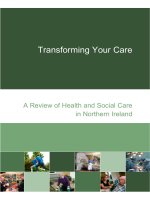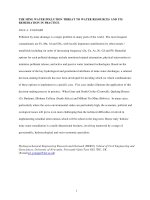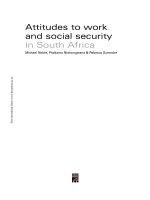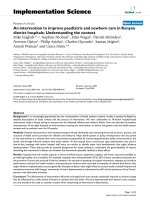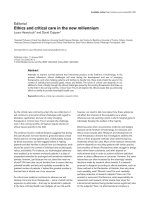Nursing students perceptions and attitudes about spirituality and spiritual care in practice
Bạn đang xem bản rút gọn của tài liệu. Xem và tải ngay bản đầy đủ của tài liệu tại đây (3.86 MB, 302 trang )
NURSING STUDENTS’ PERCEPTIONS AND ATTITUDES ABOUT
SPIRITUALITY AND SPIRITUAL CARE IN PRACTICE
TIEW LAY HWA
B. Nursing, (La Trobe), Grad Dip Advanced Nursing, (La Trobe),
M.Sc.(Training) (Leicester)
A THESIS SUBMITTED FOR THE DEGREE FOR DOCTOR OF
PHILOSOPHY (NURSING)
DEPARTMENT OF NURSING
NATIONAL UNIVERSITY OF SINGAPORE
2011
ii
Dedication
I dedicate this Doctoral Dissertation to my husband, Bob, who laboured with me on
this PhD journey. Today, I am able to submit my Thesis only because of his
unceasing love, care, motivation, encouragement, support, and inspiration. I also like
to dedicate this piece of work to the many nursing students who have participated in
this study and have allowed me to accomplish this dream. I endeavour to pass on
what I have gained and to give back to others in the areas of nursing, healthcare, and
education.
iii
Acknowledgements
It all began with God. “For everything, absolutely everything, above and below,
visible and invisible everything got started in Him and finds purpose in Him”
(Colossians1:16). Indeed, the entire PhD journey is a miraculous adventure with
God. Reflecting on the past three years when pursuing my PhD, I marvelled at God’s
loving presence, leading, guiding, and encouragement during this arduous journey.
Accordingly, the search for knowledge of spirituality has richly blessed and touched
me spiritually.
Looking back, it has been a tumultuous journey that without God’s divine
intervention, I would have abandoned early on. I recalled being given a letter and
verbal warning when I did not do so well in one of my subjects. “But with God, all
things are possible” (Matthew 19:26) and in Philippians 4:13, “I can do all things
through Christ who strengthens me.” By God’s grace, I completed my coursework
within one academic year and according to the PhD programme requirements (the
maximum timeline to complete the PhD coursework was one and half-years).
Inopportunely, I was stricken with breast cancer while pursuing my coursework.
However, God faithfully and unfailingly enabled me to pull through this sickness
and study triumphantly. Not only was I able to complete my study, I am able to
complete it miraculously within three years of study. The Lord I serve is a victorious
God and I give Him glory and thanks.
iv
Throughout this journey, God sent many people to be partners with me on. One of
the most loyal and inspiring people I know is my husband, Bob. When I reflect and
recall how Bob has helped me in this journey, it brings forth both laughter and tears.
Bob is the best husband I could wish for. He is not only my constant motivator,
listener, prayer partner, housekeeper, but also my research assistant and transport co-
ordinator ferrying me to various research study sites to recruit and conduct
interviews.
I will remain grateful to Professor Debra Creedy, my principal supervisor, who has
been very patient supervising, guiding, and encouraging me throughout this journey.
Also Associate Professor Edward Poon, friend and colleague, who patiently listened
and helped clarify the “cobwebs” in my mind when I did not understand certain
concepts in qualitative study.
I would like to thank Dr Pauline Tan, Chief Nursing Officer, who is my “boss” and
patiently stood by me when I was stressed and gave me the space and time to
conduct my research study, writing up of the thesis and numerous presentations. Dr
Chia Yen Yen, who patiently provided a listening ear when I needed to air my
frustrations and doubts.
There are others that equally played an important role in my study. They are
Assistant Professor Vicki Drury, co-supervisor, and members of my Thesis Advisory
Committee — Associate Professor Evan Lee, Assistant Professor Chow Yeow Leng,
and Associate Professor Edward Poon. Professor Desley Hegney, Director of
Research helped to address problems surfaced by me. Assistant Professor Chan
v
Moon Fai who patiently guided and taught me all that I needed to know about
biostatistics.
I also extend special thanks to staff of the three educational institutions, National
University of Singapore, Nanyang Polytechnic (NYP) and Ngee Ann Polytechnic
(NP) for their support and assistance in helping me to recruit nursing students for my
research study.
Ms Rosy Tay is another supportive partner who deserves special mention. Without
Rosy’s unwavering support, recruitment of participants would have been difficult. I
am also grateful to Ms Pearly Yuen and Dr Ngu Wah Aung (Ngee Ann Polytechnic)
who helped to facilitate data collection which enabled me to complete the research
study successfully. Also appreciate the Griffins’ prayer support and thorough
reviewing of this manuscript.
Finally, I wish to thank the 871 students of this study. It is all of you who ultimately
made this study possible and a worthwhile and fulfilling experience.
vi
Table of Contents
Dedication ii
Acknowledgements iii
Summary x
List of Tables xiii
List of Figures xiv
List of Symbols xv
Chapter 1: Background 1
1.1 Introduction 1
1.2 Interest in Spirituality 2
1.3 Spirituality in Nursing Practice 3
1.3.1 Conceptual Confusion 4
1.3.2 Do Patients Want Spiritual Care? 5
1.3.3. Nurses’ Spiritual Well-being 6
1.4 Spiritual Practice in Singapore 7
1.5 Problem Statement 7
1.6 Aims 12
1.7 Significance of the Study 12
1.8 Summary 14
1.9 Thesis Structure 14
Chapter 2: Spirituality 17
2.1 Introduction 17
2.2 Search Strategy 19
2.3 Results 19
2.3.1 Understanding Spirituality 19
2.3.2 Attitudes 22
2.3.3 Lack of Emphasis on Spirituality in Nursing Education 24
2.3.4 Organisational and Cultural Factors 27
2.3.5 Individuality 29
2.4 Conclusion 31
Chapter 3: A Review of Studies of Students’ Perceptions of Spirituality and Spiritual
Care 33
3.1 Introduction 33
3.2 Method 34
3.3 Results: Review of the Studies 40
3.3.1. Evaluation of a Specific Spiritual Education Unit 40
3.3.2. Integrating Spirituality in Undergraduate Nursing Curriculum 44
3.3.3. Different Educational Strategies of Teaching Spirituality 51
3.4 Discussion 54
3.5 Conceptual Framework 56
3.6 Conclusion 59
Chapter 4: Phase 1 Study: Qualitative Research Method 60
4.1 Introduction 60
vii
4.2 Underpinning Paradigm 60
4.3 Choice of Research Framework 62
4.3.1 Early Steps in Analysis 62
4.3.2 Use of Displays to Draw and Verify Descriptive Conclusions about the
Phenomenon 66
4.3.3 Verifying and Validating Conclusions 71
4.4 Phase 1 Data Collection Procedure 73
4.4.1 Setting and Inclusion Criteria 73
4.4.2 Sampling 73
4.4.3 Ethical Considerations 74
4.4.4 Interview Process 74
4.5 Approach to Data Analysis 75
Chapter 5: Phase 1 Study Results 77
5.1 Introduction 77
5.2 Findings Related to Spirituality 77
5.2.1 Being Human 77
5.2.2 Spiritual Well-Being 82
5.2.3 Spiritual Awareness 86
5.3 Findings Related to Spiritual Care 90
5.3.1 Antecedents for Spiritual Care 90
5.3.2 Forms of Spiritual Care 97
5.3.3 Nursing Role 102
5.4 Factors Affecting Spiritual Care-giving in Practice 106
5.4.1 Personal Factors 106
5.4.2 Systems factors 111
5.4.3 Patient and public factors 115
5.5 Summary 117
Chapter 6: Discussion of Phase 1 Study Findings 119
6.1 Introduction 119
6.2 Participants’ Characteristics, Spiritual Understanding, and Perceptions 119
6.3 Perceptions of Spiritual Well-Being 121
6.4 Relationship between Nurses’ Spiritual Well-Being and Spiritual Care-Giving
123
6.5 Spiritual Assessment as a Form of Spiritual Care 124
6.6 Relationship Between Attributes and Spiritual Care-Giving 125
6.7 Relationship Between Diverse Spiritual Understandings and Spiritual Care-
Giving 127
6.8 Relationship between Spiritual Education and Care-Giving 130
6.9 Perceived Barriers to Spiritual Care-Giving 133
6.10 Phase 1 Study Limitations 135
Chapter 7: Phase 2 Study 139
7.1 Introduction 139
7.2 Research Design 139
7.3 Setting 139
7.4 Sampling 140
7.5 Tool Development 140
7.5.1 Content Validity Results 142
viii
7.5.2 Face Validity Results 142
7.6 Pilot Study 144
7.6.1 Setting 144
7.6.2 Sample 144
7.6.3 Ethical Considerations 145
7.6.4 Instrument 145
7.6.5 Pilot Study Results 146
7.7 The Main Study 149
7.7.1 Setting 149
7.7.2 Sample 149
7.7.3 Measures 150
7.7.4 Study Procedure 151
7.8 Ethical Considerations 151
7.9 Approach to Analysis 152
7.10 Summary 153
Chapter 8: Phase 2 Study Results 154
8.1 Introduction 154
8.2 Results 154
8.2.1 Descriptive Statistics 154
8.2.2 Internal Consistency of the SCGS 155
8.2.3 Factor Analysis of the SCGS 158
8.2.4 Concurrent Validity 165
8.2.5 Results of Spiritual Care-Giving Rating Scale (SCGS) 167
8.2.6 Relationship between SCGS and Sample Characteristics 170
8.3 Summary 174
Chapter 9: Discussion of Phase 2 Study Findings 176
9.1 Study Limitations 176
9.2 Psychometric Evaluation of SCGS 177
9.2.1. Constructs of the Spiritual Care-Giving Scale (SCGS) 179
9.2.2 Spiritual Care-giving Scale (SCGS), Spirituality and Spiritual Care Rating
Scale (SSCRS) and Students Survey of Spiritual Care (SSSC) 185
9.3 Participants’ Views and Understandings about Spirituality, Spiritual Care, and
Factors Influencing Spiritual Care 187
9.4 Age and Spirituality 192
9.5 Dynamics between Spirituality, Education Programme, Ethno-Cultural
Factors, and Institution 193
9.6 Summary 196
Chapter 10: Conclusion and Recommendations 198
10.1 Introduction 198
10.2 Significance of Study 198
10.2.1 Spirituality Described 199
10.2.2 Spiritual Care Described 199
10.2.3 Factors Influencing Spiritual Care in Practice 200
10.2.4 Relationship with the Conceptual Framework 200
10.2.5 The First Locally Developed Multi-dimensional Spirituality Scale
(SCGS) 201
10.3 Implications for Nursing 201
ix
10.3.1 Implications for Nursing Education 201
10.3.2 Implications for Nursing Management 203
10.3.3 Implications for Nursing Regulators 204
10.4 Recommendations for Future Nursing Research 204
10.5 Conclusion 206
Bibliography 207
Appendix 1: Examples of Codes for Spirituality Construct 239
Appendix 2: NUS IRB Approval Letter 241
Appendix 3: Approval from Nanyang Polytechnic to Conduct Research Study 243
Appendix 4: Approval from Ngee Ann Polytechnic to Conduct Research Study . 245
Appendix 5: Participant Information Sheet and Consent Form for Phase 1 Study . 247
Appendix 6: List of Proposed Questions for Phase 1 One to One interview. 251
Appendix 7: List of Questions from Phase 1, Literature Review and Published
Instruments. 253
Appendix 8: Content Experts Panel Review Form. 259
Appendix 9: Pilot Study Instrument: Participant Demographic Details and SCGS 266
Appendix 10: Participant Information Sheet for Phase 2 Study (Pilot Study) 271
Appendix 11: Main Study Survey Instrument: Participant Demographic Details,
SCGS, SSSC & SSCRS 274
Appendix 12: Approval Letters from Authors of Published Instruments Used in the
Main Study: SSCRS and SSSC 282
Appendix 13: Participant Information Sheet for Phase 2 (Main Study) 285
x
Summary
Background
Spiritual care, a central element of holistic and multidisciplinary care, is not often
integrated into practice. In order to assess the ability of the nursing profession to
offer spiritual care, one could begin with student nurses as the next generation of
clinicians. However, there has been little exploration of student nurses’ perceptions
and attitudes towards spirituality and spiritual care.
Purpose
This exploratory study investigated nursing students’ perceptions and attitudes about
spirituality and spiritual care.
Method
A mixed-method study was conducted over two phases. In-depth interviews with a
convenience sample of 16 final-year students were conducted. Findings from the
interviews and a systematic literature review were used to construct a tool to survey
a representative sample of final-year student nurses (response rate of n=745, 61.9%).
Results
Phase 1 revealed three emerging themes for each major concept. Themes relating to
spirituality were being human, spiritual well-being, and spiritual awareness. Themes
of spiritual care were antecedents for spiritual care, forms of spiritual care, and
nursing role. Themes relating to factors influencing spiritual care in practice were
personal attributes, system factors, and patient factors.
xi
In Phase 2, the Spiritual Care-Giving scale (SCGS) was developed and tested to be
valid and reliable (α=0.96), comprising five factors: Attributes for Spiritual Care,
Spirituality Perspective, Defining Spiritual Care, Attitudes to Spiritual Care, and
Spiritual Care Values. Concurrent validity showed moderate correlation with two
other theoretically relevant scales, Spirituality and Spiritual Care Rating Scale
(SSCRS) and Student Spiritual Care Survey (SSSC).
Correlation analyses showed positive correlations between SCGS, age and
programme type. Multivariate analyses testing the relationships between nationality,
race, and institution where respondents were enrolled showed positive association
between SCGS scores and institution, (F(df=2772)=5.557; p<0.004) but no main
effects observed between SCGS score, race, nationality, and age. Post-hoc analysis
showed a significant interaction effect between race and institution
(F(df=5772)=2.547; p<0.027). It showed that race was not a main effect but was
dependent on the institution where the students were studying.
Discussion
Many findings echoed studies conducted in Western Europe and North America with
students and practising nurses. Differences were identified however in relation to
students’ perceptions of spirituality and attributes to deliver spiritual care. Students
participating in interviews perceived spirituality as universal, innate, an important
aspect of being human. Survey findings indicated that students’ demographic details,
programme type, and academic environment influenced their perceptions and
attitudes about spirituality and spiritual care. The results also supported the
theoretical coherence between the three constructs proposed in the conceptual
xii
framework (see Fig. 3.1). However, the assumed relationship that understanding
spirituality will translate into practice needs to be tested in future research.
Conclusion
The SCGS is the first validated composite tool developed and tested in a
cosmopolitan and multicultural Asian society. Spirituality and spiritual care need to
be explicitly taught in pre-registration nursing education programmes and requires
concerted effort and support by management and regulators to integrate such
practices in nursing practice and education.
xiii
List of Tables
Table Title of Table Page
Table 3.1 Overview of Included Studies 36-39
Table 7.1 Content Validity Index 143-144
Table 7.2 Item-Total Statistics for Pilot Study 148
Table 8.1 Sample Demography (n=745) 155
Table 8.2 Corrected Item-Total Correlation for 35 items
(Main Study)
157
Table 8.3 Factor Analysis (Main Study) 158
Table 8.4 Rotated Component Matrix for 35 Items 159
Table 8.5 Cronbach’s alpha and Pearson Product-Moment
Correlation Between the Three Scales
161
Table 8.6 The 5 Factor Loading Results 162
Table 8.7 SCGS Scores 169
Table 8.8 Pearson’s Product-Moment Correlations Between
Age and SCGS
170
Table 8.9 Post-Hoc Analysis of Three Different Age Groups 171
Table 8.10 Independent Samples T-test (SCGS and Programme
Types)
171
Table 8.12 Post-Hoc Analysis of the Three Institutions 172
Table 8.11 MANOVA Between SCGS, Race, Nationality, and
Institution
173
Table numbers include the Chapter number as a prefix.
xiv
List of Figures
Figure Title of Figure Page
Fig. 3.1 Conceptual Framework 59
Fig. 4.1 Coding Exemplar 63
Fig. 4.2 Pattern-coding Exemplar 65
Fig. 4.3 Illustration of “if-then” tactic 66
Fig. 4.4 Matrix Display Exemplar 68-69
Fig. 4.5 Analytic Text Summary Exemplar 70
Fig. 4.6 Exemplar of Verifying and Validating Conclusions
following Interim Analysis
72
Fig. 8.1 Plot Profile Between Institution and Race 174
Figure numbers include the Chapter number as a prefix.
xv
List of Symbols
Symbol Meaning
α
Cronbach’s alpha
p The attained level of significance
df Degree(s) of freedom
F Snedcor’s F
r Pearson’s Correlation Coefficient
t t-statistic (for Student’s/Welch’s t-test)
χ
2
Chi Squared, used in Bartlett's Test of Sphericity
n Sample size
M Mean
SD Sample Standard Deviation
Std. Error Standard Error
1
Chapter 1: Background
1.1 Introduction
There is increasing acknowledgement by a medically dominated health care system
about the value and importance of spirituality in the provision of care. Empirical
research has identified emerging evidence of a positive association between
spirituality, individual healthcare outcomes, and quality of life (Koenig, George, &
Titus, 2004; Pulchaski, 2004; Anandarajah, 2008; Meraviglia, 2004; Burkhart &
Hogan, 2009).
Indeed, there are many extraordinary stories about ordinary people who, against all
odds, overcome life’s challenges and adversities. Rolheiser (2001, cited in Miner-
Williams, 2006) ascribed these outcomes to individuals yearning to find meaning
and significance for suffering, illness, and death. At such times, individuals seek to
move from their sense of brokenness to a sense of wholeness (Miner-Williams,
2006). According to Puchalski (2004), spirituality is that aspect within the human
being that seeks to heal or be whole.
This chapter outlines reasons for the growing interest in spirituality and more
specifically the importance of spirituality in nursing care. Despite its importance,
many nurses struggle to provide spiritual care and some reasons are offered as to
why this may be. Discussion of these reasons provides the basis for the aims of this
programme of research. The significance of the study is outlined and the chapter
concludes with an overview of the thesis.
2
1.2 Interest in Spirituality
Up until the 1980s there was relatively little published research on spirituality but
this has been changing. There are several possible reasons for the increasing interest
in spirituality. Philosophically, spirituality is aesthetically and morally appealing to
most people (Hussey, 2009). Studies report that spirituality can be a powerful coping
resource for patients with health-related problems such as chronic illnesses and
advanced diseases (Narayanasamy, 2007). Furthermore, in response to the growing
global ageing population and increasing proportion of those living with a chronic
condition, there has been a shift of focus from curing to healing (Adegbola, 2006).
Spirituality has more prominence for individuals when the medical system is
perceived to be unable to meet their needs; and the person begins to look toward
spirituality for meaning, purpose, and understanding (Puchalski, 2004).
A Gallup survey in 2002 in the United States of America (USA) showed that as
people age, spirituality increases in importance. Spirituality becomes a source of
hope and aids their adaptation to illness (Gaskamp, Sutter, & Meraviglia, 2006).
According to Mueller, Plevak, & Rummans (2001), national surveys of both the
general population and patients have consistently indicated a belief in a higher being
and the power of God to improve their course of illness; and a desire for spirituality
to be incorporated into their healthcare management.
In a National Inpatient Priority Index survey conducted in the USA, hospitalised
patients placed a high value and importance on having their emotional and spiritual
needs met (Clark , Drain, & Malone, 2003). Hospitals that achieved a higher index in
these categories by survey respondents also achieved higher patient satisfaction
3
ratings and were more likely to be recommended to others. In the Asian context,
elderly Chinese men (n=1300) participating in a recent study in Singapore indicated
a belief that spirituality helped them to age better and successfully. The researchers
concluded that “ spirituality, and were salient factors associated with successful
aging.” (Ng, Broekman, Niti, Gwee, & Kua, 2009, p. 414).
1.3 Spirituality in Nursing Practice
In recognition of the importance of spirituality in nursing practice, legislation,
statutory regulations and professional guidelines have been established in some
countries (Chan, 2009; Gordon & Mitchell, 2004). Similarly, codes of conduct
developed by nursing organizations around the world have attempted to outline the
professional obligations of nurses to meet patients’ spiritual needs (McEwen, 2005;
Paley, 2008a). Despite these measures, attending to patients’ spirituality is still a
much neglected area of practice (Swinton, 2006; Vance, 2001; Oldnall, 1996).
McSherry , Cash, and Ross (2004) contend that existing professional guidelines and
legislative frameworks are underpinned by two major assumptions: (1) patients and
nurses are aware of their own spirituality and have mutual understanding and
agreement about this concept; and (2) patients and users of healthcare services
expect to have their spiritual needs addressed. Possible factors underpinning the lack
of integration of spirituality in practice are explored in the following sections and
include conceptual confusion, perceived needs of patients, nurses’ spiritual well-
being and perceptions of spirituality.
4
1.3.1 Conceptual Confusion
There is confusion surrounding the meaning of spirituality and how it is interpreted
and understood by both nurses and patients (McSherry & Cash, 2004). Tan,
Braunack-Mayer and Beilby (2005) suggested that this confusion could be due to
language and terms used when defining and discussing spirituality. As “spirituality
is an elusive, difficult to define, poorly understood notion” (Paley 2008c, p. 177),
attempting to describe and define it can render it a vague term with no real
significance (McSherry & Cash, 2004). Swinton (2006) argued that attempts to
define spirituality by adopting a “one size fits all” approach should be evaluated
critically (p. 920). The term could potentially become so broad in its meaning to
accommodate all perspectives that it loses any real significance.
For example, a controversial court ruling on December 31, 2009 in Malaysia,
permitted non-Muslims to continue to use the word “Allah” as a translation for
“God” in Malay. However, some Muslims argued the word is exclusive to Islam, and
that its use by others could confuse Muslims and cause them to convert to
Christianity (Hassan, 2010). This controversy raised possible concerns about the
appropriateness of religious definitions and meanings for spirituality being adopted
by a global discipline such as nursing (Paley, 2008b; 2008c). Equally, professionals
from other disciplines, such as sociology, psychology, theology, and allied health
may challenge the adoption of certain religious definitions of spirituality in health
care more generally (Tan et al., 2005).
Most definitions of spirituality, spiritual health, and spiritual well-being are
culturally bound. For example, the Ellison Spiritual Well-being Score uses the
concept of divinity which is applicable to Jewish, Christian, and Muslim populations
5
(Ellis, Vinson, & Ewigman, 1999). There are other religious or traditional beliefs
such as Taoism, Buddhism, ancestral worship, and Hinduism that were not included.
The tool may therefore not be sufficiently ethno-culturally diverse to accommodate
these different perspectives and be used in multicultural societies.
The meaning and use of spirituality, therefore, should be studied carefully from
various cultural perspectives. Swinton (2006) argued that many authors make claims
about the meanings of spirituality but may not substantiate their views. What can be
asserted without evidence can also be dismissed without evidence. It is therefore
important to discuss spirituality in terms of an evidence-based framework.
Spirituality in nursing requires the profession to seek a “conceptual and theoretical
unity” (Clarke 2009, p. 1667). This means finding a common understanding, which
in turn will contribute to consistency in the terminology and language used to
describe it. With a clear articulation of what spirituality means, the discipline of
nursing may be able to espouse how nurses perceive the phenomenon. All healthcare
professionals attending to patients’ spiritual needs should possess a breadth and
depth of understanding to embrace an individual’s uniqueness (McSherry et al.,
2004). Such an approach may enable measurement of attitudes and understanding to
be utilised to inform pre-registration education, professional development, practice
guidelines and contribute to theory development.
1.3.2 Do Patients Want Spiritual Care?
Although high patient satisfaction scores have been associated with meeting patients’
emotional and spiritual needs (Clark et al., 2003), it should not be assumed that all
patients are receptive and would like nurses to attend to their spiritual needs
(McSherry, 2007). One survey identified that patients may or may not expect
6
spiritual care-giving from nurses (Taylor & Mamier, 2004). According to some
patients in another study, the generation gap between the patient and nurse can be an
obstacle (van Leeuwen, Tiesinga, Jochemsen, & Post, 2007). Some participants
reported that they would prefer to talk about spiritual issues with older nurses.
Others cited factors such as differences in life experiences, upbringing, spiritual
involvement, and cultural aspects that affected their desire to relate to nurses about
spirituality issues (Taylor & Mamier, 2004; Pesut 2008a, 2008b; Pesut & Thorne,
2007). Other researchers concluded that the views, perceptions, attitudes, and desires
for such care by the patient should be sought (Conner & Eller, 2004; Taylor &
Mamier, 2004; Pesut, 2008a; 2009; Pesut & Reimer-Kirkham, 2010).
1.3.3. Nurses’ Spiritual Well-being
Delivering spiritual care requires the nurse to engage with the patient at the heart of
human experience, listening to their experiences and exploring their spiritual needs.
Research has shown that nurses are likely to provide spiritual care effectively if they
are “grounded” in their understanding about spirituality (Hegarty, 2007, p. 46). Their
ability to appreciate, understand, and be spiritually aware enables them to ”bracket”
their spirituality and attend to patients’ spiritual needs with sincerity, respect, and
trust (Hegarty, 2007, p.46). Ramsden (cited in Hegarty, 2007) notes that nurses
should be “regardful” and responsive to individuals’ unique culture, be open, and
accepting of one’s limits and to set aside any defensiveness (p.46).
This openness towards others requires nurses to acknowledge the presence of
different perspectives and their engagement with life (Hegarty, 2007). Equally
important is the nurturing of nurses’ own spiritual well-being. It was reported that
care-providers with higher levels of spiritual well-being tend to have favourable
7
attitudes toward spiritual care and are more sensitive to the spiritual needs of patients
(Treloar, 2000; Stranahan, 2001; Lundmark, 2006; Fisher & Brumley, 2008).
1.4 Spiritual Practice in Singapore
Singaporean society is a highly religious tolerant society. People are free to choose,
practise, observe, and respect one another’s religious, cultural and spiritual beliefs.
Little is known about spiritual practice in healthcare, magnitude of patients’ spiritual
needs and support they obtained from healthcare professionals. Through
observations, anecdotal evidence and conversations with nursing and healthcare
colleagues, conceptual confusion regarding spirituality and spiritual practice
appeared to be common. Furthermore, permission was not given to review nursing
diploma curricula, except for the degree programme, so there was lack of
understanding and knowledge of spiritual education and practice in Singapore.
1.5 Problem Statement
There is a professional mandate for nurses to provide spiritual care (Gordon &
Mitchell, 2004; Stern & James, 2006). Yet there is relatively little published about
the way nurses learn about spiritual aspects of care. Given that spirituality is difficult
to define and poorly understood, the role of education in spiritual development is
highlighted.
In a systematic literature review of thirteen studies published between 1985 and
2003, it was found that age per se appeared less important in the development of
spirituality (Dalby, 2006). Instead, the review highlighted the complexity of the
question of spirituality development.
8
There is a view in the psychological literature that children may not understand
abstract notions related to spirituality as they are developmentally immature, lack
sufficient ego, development and intellectual capacity (Hart & Ailoae, 2007). These
assumptions are derived from the rational thinking style of adults on defining
spiritual life. Heilferty (2004) however, argued that children have spiritual awareness
and that this awareness colours their perceptions of everything in their lives that
matters to them. Furthermore, the spiritual nature of young people has now started to
gain more attention and appreciation of its significance for later development (Hart
& Ailoae, 2007).
Research indicates the importance of incorporating spiritual education in nursing
undergraduate curricula in order to raise students’ spiritual awareness and
development. However, since the 1980s, systematic studies and anecdotal nurses’
accounts have not shown apparent heightened spiritual awareness and interest among
the profession (Musgrave & McFarlane, 2003). Despite published reports that
spiritual education has been incorporated into various programmes (Catanzaro &
McMullen, 2001; Pesut, 2002; Lemmer, 2002; Meyer, 2003; Baldacchino, 2008;
Lantz, 2007) most studies consistently reported that nurses felt inadequately
prepared for this role (Highfield, Taylor, & Amenta, 2000; Stranahan, 2001; Ross,
2006; Hubbell, Woodard, Barksdale-Brown, & Parker, 2006; Carr, 2008).
Some studies have explored nurses’ perceptions of spiritual care (McSherry, 2007;
Stranahan, 2001) and nursing students’ spiritual care learning (Pesut, 2002;
Baldacchino, 2008) but virtually none have investigated nursing students’ spiritual
awareness, their perceptions and understanding of spirituality and their role in
9
spiritual care (McSherry, Gretton, Draper, & Watson, 2008). Recent research
identified that when young persons conceptualised life experiences as spiritual
experiences their spiritual development was enhanced (Hart & Ailoae, 2007). Hart &
Ailoae (2007) commented that these experiences are direct, personal and often have
an effect, though momentarily, “waking us up” (p. 347) to pursue the spiritual quest
especially through wondering, questioning, and searching for meaning (e.g., “Who
am I?”). Therefore, knowledge about factors that influence nursing students’
spiritual development and awareness warrants investigation.
It could also be argued that the current generation of students may have different
worldviews, cultural beliefs and values about spirituality and spiritual care from
previous generations of nurses due to secularisation and modernisation in society.
Given these varied perspectives, there is a need to understand students’ views and
insights noting how their spiritual development is shaped by their worldview,
experiences, global changes, and moral orientation (Hart & Ailoae, 2007).
Most studies on spirituality have been conducted in either North America or the
United Kingdom. Samples were usually homogenous and participants identified with
Western religions and cultural beliefs. This means that any insights gained and
subsequent theory by default reflects a Judeo-Christian perspective (Paley, 2008b,
2008c, 2009). To fully understand and describe the meaning of spirituality and
spiritual care/needs, further research is required that includes culturally and
religiously diverse samples and perspectives (Conner & Ellen, 2004; Creel, 2007).
Insights into how nurses perceive spirituality and spiritual care could help to inform
and shape practice and education. Studies conducted in Hong Kong and Taiwan
10
indicated perceived differences in Western and Chinese cultures, religions and
beliefs that may affect how the Chinese perceive spirituality, spiritual needs, and
desired spiritual care (Mok, Wong, & Wong, 2009; Chung, Wong & Chan, 2007;
Shih, Gau, Mao, Chen, & Lo, 2001).
There has been a lack of progress in relation to the development and implementation
of spirituality in practice. Indeed it could be argued that there is a disconnect
between theory and practice. While existing studies have explored some of the
reasons for the gap between theory and practice, many of these have been anecdotal,
and issues have not been studied systematically and empirically (McEwen, 2005;
Swinton, 2006). There continues to be a noticeable absence of studies in the
literature that focus on nurses’ and students’ perceptions of spirituality (Ross, 2006;
Chism & Magnam, 2009) generally and from Asian countries specifically. A review
of eight nursing research papers conducted with nursing students and published
between 1990 and 2010 showed that the focus was mainly on spirituality content in
curricula, and the impact of specific spiritual education modules or teaching
strategies on students’ spiritual perspectives (Pesut, 2002; Baldacchino, 2008;
Mooney & Timmins, 2007; McSherry et al., 2008; Meyer, 2003; Wallace,
Campbell,
Grossman, Shea, Lange, & Quell, 2008; Hoffert,
Henshaw, & Mvududu, 2007; van
Leeuwen, Tiesinga, Middel, Post, & Jochemsen, 2009). There was no study
specifically investigating students’ perspectives of barriers influencing spiritual
understanding and spiritual care in practice (McSherry et al., 2008; Chism &
Magnam, 2009).
